Σύνδεση
Αναζήτηση
Πρόσφατα Θέματα
Παρόντες χρήστες
1 χρήστης είναι συνδεδεμένος αυτήν την στιγμή:: 0 μέλη, 0 μη ορατοί και 1 επισκέπτης Κανένας
Περισσότεροι χρήστες υπό σύνδεση 28, στις Τετ Ιαν 25, 2017 1:10 am
Clock
Astronomy Picture of the Day
Σελίδα 2 από 15
Σελίδα 2 από 15 •  1, 2, 3 ... 8 ... 15
1, 2, 3 ... 8 ... 15 
 2017 January 12
2017 January 12
2017 January 12
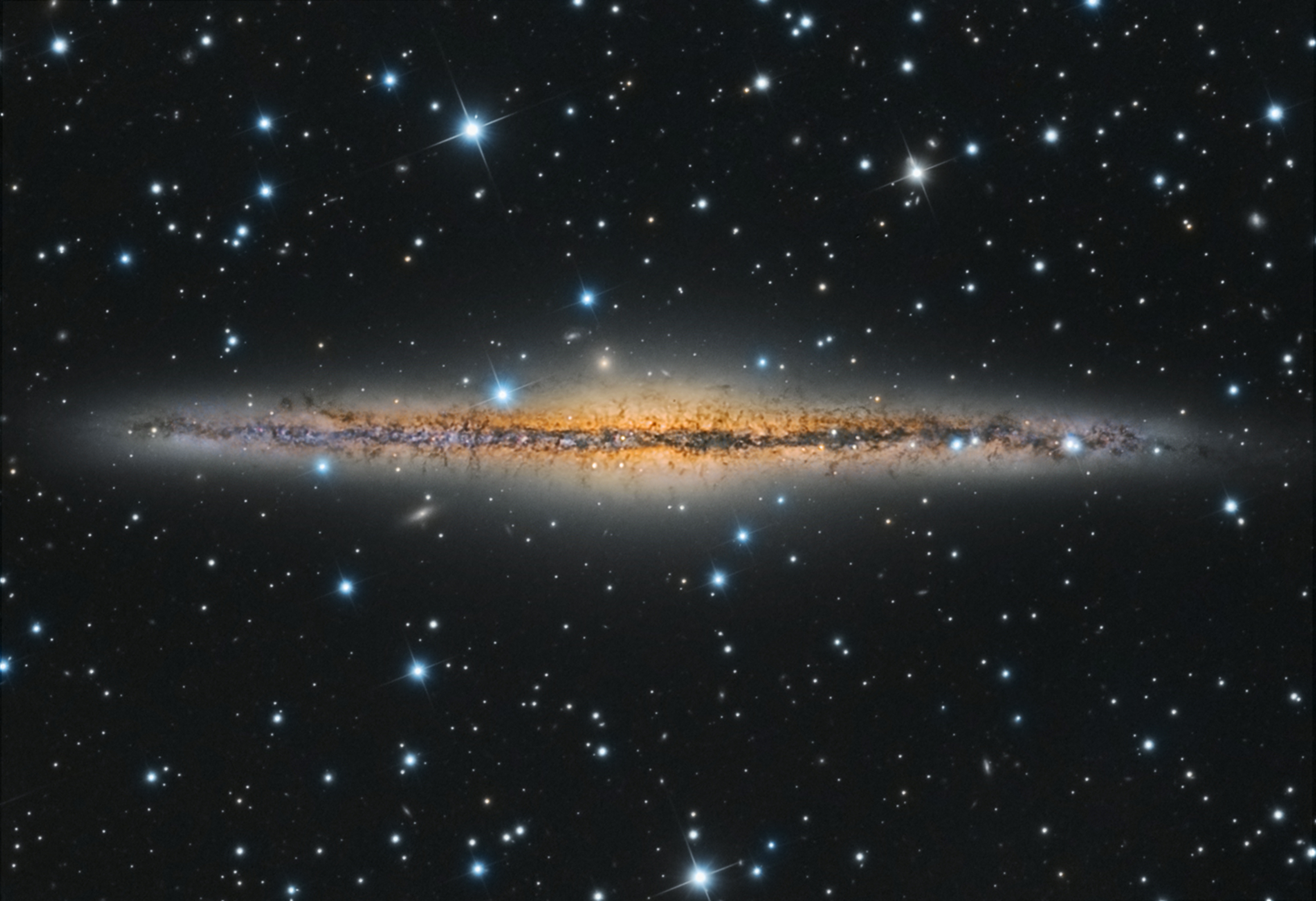
Edge-On NGC 891
Image Credit & Copyright: Alessandro Falesiedi
Explanation: Large spiral galaxy NGC 891 spans about 100 thousand light-years and is seen almost exactly edge-on from our perspective. In fact, about 30 million light-years distant in the constellation Andromeda, NGC 891 looks a lot like our Milky Way. At first glance, it has a flat, thin, galactic disk of stars and a central bulge cut along the middle by regions of dark obscuring dust. But remarkably apparent in NGC 891's edge-on presentation are filaments of dust that extend hundreds of light-years above and below the center line. The dust has likely been blown out of the disk by supernova explosions or intense star formation activity. Fainter galaxies can also be seen near the edge-on disk in this deep portrait of NGC 891.

Edge-On NGC 891
Image Credit & Copyright: Alessandro Falesiedi
Explanation: Large spiral galaxy NGC 891 spans about 100 thousand light-years and is seen almost exactly edge-on from our perspective. In fact, about 30 million light-years distant in the constellation Andromeda, NGC 891 looks a lot like our Milky Way. At first glance, it has a flat, thin, galactic disk of stars and a central bulge cut along the middle by regions of dark obscuring dust. But remarkably apparent in NGC 891's edge-on presentation are filaments of dust that extend hundreds of light-years above and below the center line. The dust has likely been blown out of the disk by supernova explosions or intense star formation activity. Fainter galaxies can also be seen near the edge-on disk in this deep portrait of NGC 891.

panosol- Αριθμός μηνυμάτων : 762
Points : 927
Reputation : 15
Ημερομηνία εγγραφής : 17/06/2012
Ηλικία : 56
 2017 January 13
2017 January 13
2017 January 13

When Mars met Neptune
Image Credit & Copyright: Stephen Mudge
Explanation: On January 1, a Mars-assisted viewing opportunity allowed binocular-equipped skygazers to cross an ice giant off their life list. Remarkably, the line-of-sight to the bright Red Planet could guide you to within 0.02 degrees of a faint, pale Neptune in Earth's night skies. Taken within 3 hours of their closest conjunction, these panels capture the odd couple's appearance in skies over Brisbane, Australia. A wide field view includes the new year's slender crescent moon near the western horizon and Venus as the brilliant evening star. Mars and Neptune are indicated at the upper right. The two inset magnified views were taken with the same telephoto lens and so do show the Mars-Neptune conjunction and the apparent size of the crescent moon at the same scale. This week Neptune hangs out near Venus on the western sky.

When Mars met Neptune
Image Credit & Copyright: Stephen Mudge
Explanation: On January 1, a Mars-assisted viewing opportunity allowed binocular-equipped skygazers to cross an ice giant off their life list. Remarkably, the line-of-sight to the bright Red Planet could guide you to within 0.02 degrees of a faint, pale Neptune in Earth's night skies. Taken within 3 hours of their closest conjunction, these panels capture the odd couple's appearance in skies over Brisbane, Australia. A wide field view includes the new year's slender crescent moon near the western horizon and Venus as the brilliant evening star. Mars and Neptune are indicated at the upper right. The two inset magnified views were taken with the same telephoto lens and so do show the Mars-Neptune conjunction and the apparent size of the crescent moon at the same scale. This week Neptune hangs out near Venus on the western sky.

panosol- Αριθμός μηνυμάτων : 762
Points : 927
Reputation : 15
Ημερομηνία εγγραφής : 17/06/2012
Ηλικία : 56
 2017 January 14
2017 January 14
2017 January 14
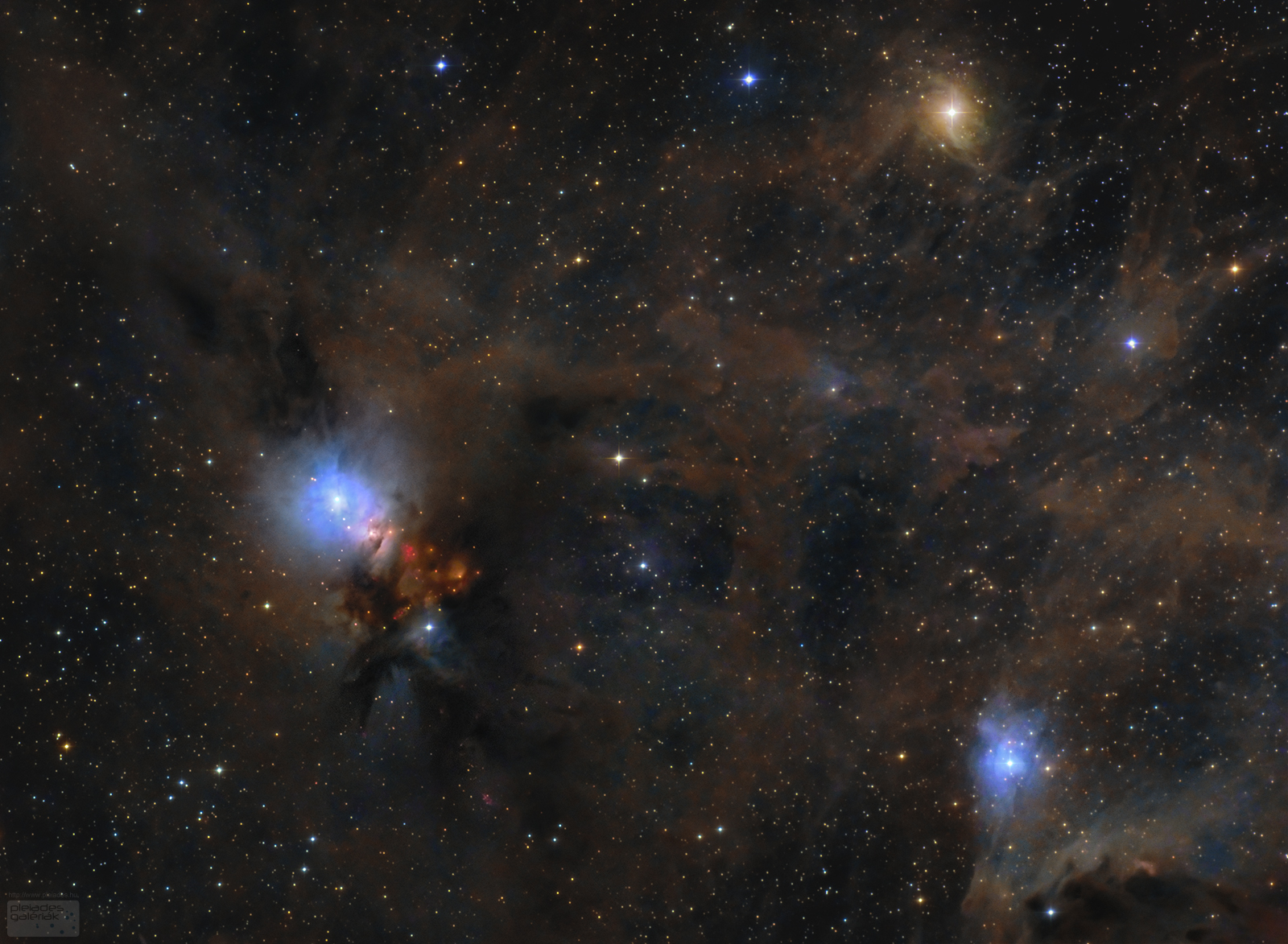
Stardust in the Perseus Molecular Cloud
Image Credit & Copyright: Lorand Fenyes
Explanation: Clouds of stardust drift through this deep skyscape. The cosmic scene spans nearly 2 degrees across the Perseus molecular cloud some 850 light-years away. A triangle of dusty nebulae reflecting light from embedded stars is captured in the telescopic field of view. With a characteristic bluish color reflection nebula NGC 1333 is at left, vdB13 at bottom right, and rare yellowish reflection nebula vdB12 lies at the top. Stars are forming in the Perseus molecular cloud, though most are obscured at visible wavelengths by the pervasive dust. Still, hints of contrasting red emission from Herbig-Haro objects, the jets and shocked glowing gas emanating from recently formed stars, are evident in NGC 1333. At the estimated distance of the molecular cloud, legs of the triangle formed by the reflection nebulae would be about 20 light-years long.

Stardust in the Perseus Molecular Cloud
Image Credit & Copyright: Lorand Fenyes
Explanation: Clouds of stardust drift through this deep skyscape. The cosmic scene spans nearly 2 degrees across the Perseus molecular cloud some 850 light-years away. A triangle of dusty nebulae reflecting light from embedded stars is captured in the telescopic field of view. With a characteristic bluish color reflection nebula NGC 1333 is at left, vdB13 at bottom right, and rare yellowish reflection nebula vdB12 lies at the top. Stars are forming in the Perseus molecular cloud, though most are obscured at visible wavelengths by the pervasive dust. Still, hints of contrasting red emission from Herbig-Haro objects, the jets and shocked glowing gas emanating from recently formed stars, are evident in NGC 1333. At the estimated distance of the molecular cloud, legs of the triangle formed by the reflection nebulae would be about 20 light-years long.

panosol- Αριθμός μηνυμάτων : 762
Points : 927
Reputation : 15
Ημερομηνία εγγραφής : 17/06/2012
Ηλικία : 56
 2017 January 15
2017 January 15
2017 January 15

The Matter of the Bullet Cluster
Image Credit: X-ray: NASA/CXC/CfA/ M. Markevitch et al.;
Lensing Map: NASA/STScI; ESO WFI; Magellan/U.Arizona/ D.Clowe et al.
Optical: NASA/STScI; Magellan/U.Arizona/D.Clowe et al.
Explanation: What's the matter with the Bullet Cluster? This massive cluster of galaxies (1E 0657-558) creates gravitational lens distortions of background galaxies in a way that has been interpreted as strong evidence for the leading theory: that dark matter exists within. Different recent analyses, though, indicate that a less popular alternative -- modifying gravity-- could explain cluster dynamics without dark matter, and provide a more likely progenitor scenario as well. Currently, the two scientific hypotheses are competing to explain the observations: it's invisible matter versus amended gravity. The duel is dramatic as a clear Bullet-proof example of dark matter would shatter the simplicity of modified gravity theories. For the near future, the battle over the Bullet cluster is likely to continue as new observations, computer simulations, and analyses are completed. The featured image is a Hubble/Chandra/Magellan composite with red depicting the X-rays emitted by hot gas, and blue depicting the suggested separated dark matter distribution.

The Matter of the Bullet Cluster
Image Credit: X-ray: NASA/CXC/CfA/ M. Markevitch et al.;
Lensing Map: NASA/STScI; ESO WFI; Magellan/U.Arizona/ D.Clowe et al.
Optical: NASA/STScI; Magellan/U.Arizona/D.Clowe et al.
Explanation: What's the matter with the Bullet Cluster? This massive cluster of galaxies (1E 0657-558) creates gravitational lens distortions of background galaxies in a way that has been interpreted as strong evidence for the leading theory: that dark matter exists within. Different recent analyses, though, indicate that a less popular alternative -- modifying gravity-- could explain cluster dynamics without dark matter, and provide a more likely progenitor scenario as well. Currently, the two scientific hypotheses are competing to explain the observations: it's invisible matter versus amended gravity. The duel is dramatic as a clear Bullet-proof example of dark matter would shatter the simplicity of modified gravity theories. For the near future, the battle over the Bullet cluster is likely to continue as new observations, computer simulations, and analyses are completed. The featured image is a Hubble/Chandra/Magellan composite with red depicting the X-rays emitted by hot gas, and blue depicting the suggested separated dark matter distribution.

panosol- Αριθμός μηνυμάτων : 762
Points : 927
Reputation : 15
Ημερομηνία εγγραφής : 17/06/2012
Ηλικία : 56
 2017 January 16
2017 January 16
2017 January 16
Geostationary Highway through Orion
Image Credit & Copyright: James A. DeYoung
Explanation: Put a satellite in a circular orbit about 42,000 kilometers from the center of the Earth and it will orbit once in 24 hours. Because that matches Earth's rotation period, it is known as a geosynchronous orbit. If that orbit is also in the plane of the equator, the satellite will hang in the sky over a fixed location in a geostationary orbit. As predicted in the 1940s by futurist Arthur C. Clarke, geostationary orbits are in common use for communication and weather satellites, a scenario now well-known to astroimagers. Deep images of the night sky made with telescopes that follow the stars can also pick up geostationary satellites glinting in sunlight still shining far above the Earth's surface. Because they all move with the Earth's rotation against the background of stars, the satellites leave trails that seem to follow a highway across the celestial landscape. The phenomenon was captured last month in this video showing several satellites in geostationary orbit crossing the famous Orion Nebula.
Geostationary Highway through Orion
Image Credit & Copyright: James A. DeYoung
Explanation: Put a satellite in a circular orbit about 42,000 kilometers from the center of the Earth and it will orbit once in 24 hours. Because that matches Earth's rotation period, it is known as a geosynchronous orbit. If that orbit is also in the plane of the equator, the satellite will hang in the sky over a fixed location in a geostationary orbit. As predicted in the 1940s by futurist Arthur C. Clarke, geostationary orbits are in common use for communication and weather satellites, a scenario now well-known to astroimagers. Deep images of the night sky made with telescopes that follow the stars can also pick up geostationary satellites glinting in sunlight still shining far above the Earth's surface. Because they all move with the Earth's rotation against the background of stars, the satellites leave trails that seem to follow a highway across the celestial landscape. The phenomenon was captured last month in this video showing several satellites in geostationary orbit crossing the famous Orion Nebula.

panosol- Αριθμός μηνυμάτων : 762
Points : 927
Reputation : 15
Ημερομηνία εγγραφής : 17/06/2012
Ηλικία : 56
 2017 January 17
2017 January 17
2017 January 17

Fly Me to the Moon
Image Credit & Copyright: Tamas Ladanyi (TWAN)
Explanation: No, this is not a good way to get to the Moon. What is pictured is a chance superposition of an airplane and the Moon. The contrail would normally appear white, but the large volume of air toward the setting Sun preferentially knocks away blue light, giving the reflected trail a bright red hue. Far in the distance, to the right of the plane, is the young Moon. This vast world shows only a sliver of itself because the Sun is nearly lined up behind it. Captured two weeks ago, the featured image was framed by an eerie maroon sky, too far from day to be blue, too far from night to be black. Within minutes the impromptu sky show ended. The plane crossed the Moon. The contrail dispersed. The Sun set. The Moon set. The sky faded to black, only to reveal thousands of stars that had been too faint to see through the rustic red din.

Fly Me to the Moon
Image Credit & Copyright: Tamas Ladanyi (TWAN)
Explanation: No, this is not a good way to get to the Moon. What is pictured is a chance superposition of an airplane and the Moon. The contrail would normally appear white, but the large volume of air toward the setting Sun preferentially knocks away blue light, giving the reflected trail a bright red hue. Far in the distance, to the right of the plane, is the young Moon. This vast world shows only a sliver of itself because the Sun is nearly lined up behind it. Captured two weeks ago, the featured image was framed by an eerie maroon sky, too far from day to be blue, too far from night to be black. Within minutes the impromptu sky show ended. The plane crossed the Moon. The contrail dispersed. The Sun set. The Moon set. The sky faded to black, only to reveal thousands of stars that had been too faint to see through the rustic red din.

panosol- Αριθμός μηνυμάτων : 762
Points : 927
Reputation : 15
Ημερομηνία εγγραφής : 17/06/2012
Ηλικία : 56
 2017 January 18
2017 January 18
2017 January 18

Space Station Vista: Planet and Galaxy
Image Credit: NASA, JSC, ESRS
Explanation: If you could circle the Earth aboard the International Space Station, what might you see? Some amazing vistas, one of which was captured in this breathtaking picture in mid-2015. First, visible at the top, are parts of the space station itself including solar panels. Just below the station is the band of our Milky Way Galaxy, glowing with the combined light of billions of stars, but dimmed in patches by filaments of dark dust. The band of red light just below the Milky Way is airglow -- Earth's atmosphere excited by the Sun and glowing in specific colors of light. Green airglow is visible below the red. Of course that's our Earth below its air, with the terminator between day and night visible near the horizon. As clouds speckle the planet, illumination from a bright lightning bolt is seen toward the lower right. Between work assignments, astronauts from all over the Earth have been enjoying vistas like this from the space station since the year 2000.

Space Station Vista: Planet and Galaxy
Image Credit: NASA, JSC, ESRS
Explanation: If you could circle the Earth aboard the International Space Station, what might you see? Some amazing vistas, one of which was captured in this breathtaking picture in mid-2015. First, visible at the top, are parts of the space station itself including solar panels. Just below the station is the band of our Milky Way Galaxy, glowing with the combined light of billions of stars, but dimmed in patches by filaments of dark dust. The band of red light just below the Milky Way is airglow -- Earth's atmosphere excited by the Sun and glowing in specific colors of light. Green airglow is visible below the red. Of course that's our Earth below its air, with the terminator between day and night visible near the horizon. As clouds speckle the planet, illumination from a bright lightning bolt is seen toward the lower right. Between work assignments, astronauts from all over the Earth have been enjoying vistas like this from the space station since the year 2000.

panosol- Αριθμός μηνυμάτων : 762
Points : 927
Reputation : 15
Ημερομηνία εγγραφής : 17/06/2012
Ηλικία : 56
 2017 January 19
2017 January 19
2017 January 19
GB-finalLeshin2048.jpg)
The Elephant's Trunk Nebula in Cepheus
Image Credit & Copyright: Stephen Leshin
Explanation: Like an illustration in a galactic Just So Story, the Elephant's Trunk Nebula winds through the emission nebula and young star cluster complex IC 1396, in the high and far off constellation of Cepheus. Also known as vdB 142, the cosmic elephant's trunk is over 20 light-years long. This colorful close-up view includes image data from a narrow band filter that transmits the light from ionized hydrogen atoms in the region. The resulting composite highlights the bright swept-back ridges that outline pockets of cool interstellar dust and gas. Such embedded, dark, tendril-shaped clouds contain the raw material for star formation and hide protostars within. Nearly 3,000 light-years distant, the relatively faint IC 1396 complex covers a large region on the sky, spanning over 5 degrees. This dramatic scene spans a 1 degree wide field, about the size of 2 Full Moons.
GB-finalLeshin2048.jpg)
The Elephant's Trunk Nebula in Cepheus
Image Credit & Copyright: Stephen Leshin
Explanation: Like an illustration in a galactic Just So Story, the Elephant's Trunk Nebula winds through the emission nebula and young star cluster complex IC 1396, in the high and far off constellation of Cepheus. Also known as vdB 142, the cosmic elephant's trunk is over 20 light-years long. This colorful close-up view includes image data from a narrow band filter that transmits the light from ionized hydrogen atoms in the region. The resulting composite highlights the bright swept-back ridges that outline pockets of cool interstellar dust and gas. Such embedded, dark, tendril-shaped clouds contain the raw material for star formation and hide protostars within. Nearly 3,000 light-years distant, the relatively faint IC 1396 complex covers a large region on the sky, spanning over 5 degrees. This dramatic scene spans a 1 degree wide field, about the size of 2 Full Moons.

panosol- Αριθμός μηνυμάτων : 762
Points : 927
Reputation : 15
Ημερομηνία εγγραφής : 17/06/2012
Ηλικία : 56
 2017 January 20
2017 January 20
2017 January 20
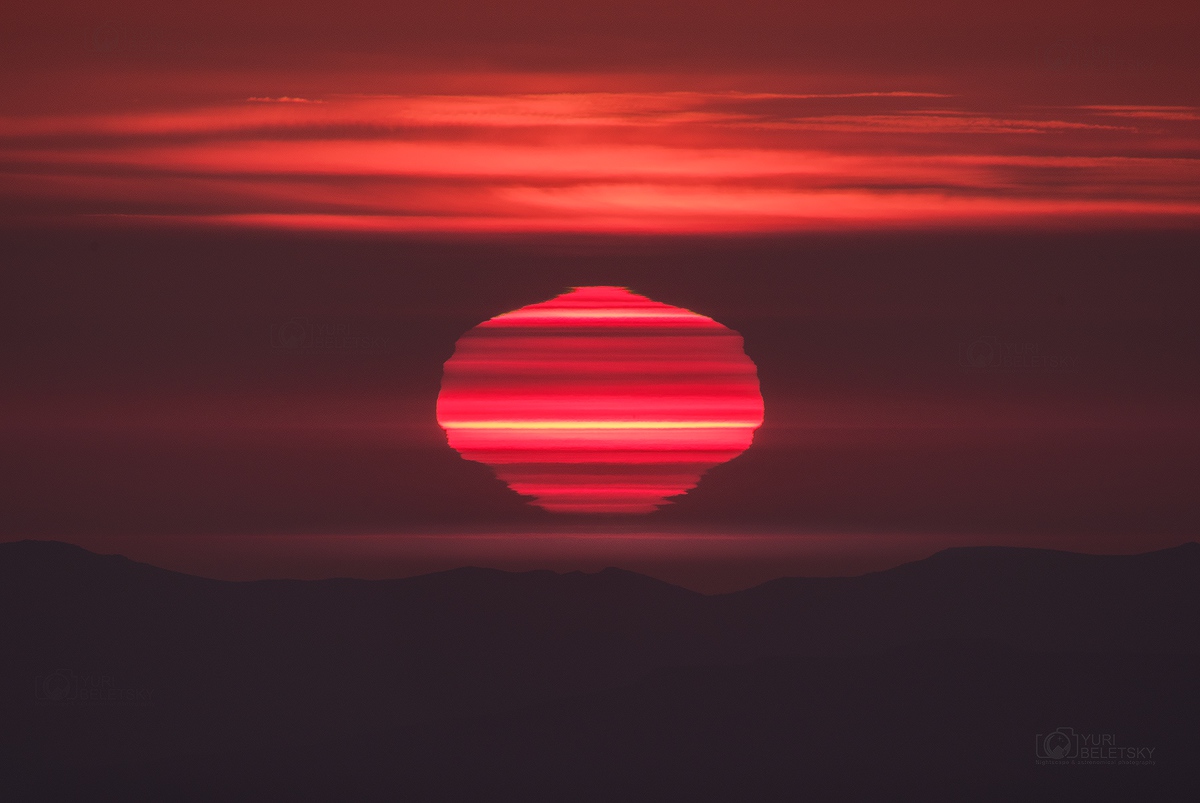
Layer Cake Sunset
Image Credit & Copyright: Yuri Beletsky (Carnegie Las Campanas Observatory, TWAN)
Explanation: On January 18 a tantalizing sunset was captured in this snapshot. Seemingly sliced into many horizontal layers the Sun shimmered moments before it touched the horizon, setting over the Pacific Ocean as seen from the mountaintop Las Campanas Observatory in Chile. Pink hues of filtered sunlight were created by the long sight-line through the hazy atmosphere. But the remarkable layers correspond to low atmospheric layers of sharply different temperature and density also along the line of sight. Over a long path through each layer the rays of sunlight are refracted strongly and create different images or mirages of sections of the setting Sun.

Layer Cake Sunset
Image Credit & Copyright: Yuri Beletsky (Carnegie Las Campanas Observatory, TWAN)
Explanation: On January 18 a tantalizing sunset was captured in this snapshot. Seemingly sliced into many horizontal layers the Sun shimmered moments before it touched the horizon, setting over the Pacific Ocean as seen from the mountaintop Las Campanas Observatory in Chile. Pink hues of filtered sunlight were created by the long sight-line through the hazy atmosphere. But the remarkable layers correspond to low atmospheric layers of sharply different temperature and density also along the line of sight. Over a long path through each layer the rays of sunlight are refracted strongly and create different images or mirages of sections of the setting Sun.

panosol- Αριθμός μηνυμάτων : 762
Points : 927
Reputation : 15
Ημερομηνία εγγραφής : 17/06/2012
Ηλικία : 56
 2017 January 21
2017 January 21
2017 January 21

Daphnis the Wavemaker
Image Credit: Cassini Imaging Team, SSI, JPL, ESA, NASA
Explanation: Plunging close to the outer edges of Saturn's rings, on January 16 the Cassini spacecraft captured this closest yet view of Daphnis. About 8 kilometers across and orbiting within the bright ring system's Keeler gap, the small moon is making waves. The 42-kilometer wide outer gap is foreshortened in the image by Cassini's viewing angle. Raised by the influenced of the small moon's weak gravity as it crosses the frame from left to right, the waves are formed in the ring material at the edge of the gap. A faint wave-like trace of ring material is just visible trailing close behind Daphnis. Remarkable details on Daphnis can also be seen, including a narrow ridge around its equator, likely an accumulation of particles from the ring.

Daphnis the Wavemaker
Image Credit: Cassini Imaging Team, SSI, JPL, ESA, NASA
Explanation: Plunging close to the outer edges of Saturn's rings, on January 16 the Cassini spacecraft captured this closest yet view of Daphnis. About 8 kilometers across and orbiting within the bright ring system's Keeler gap, the small moon is making waves. The 42-kilometer wide outer gap is foreshortened in the image by Cassini's viewing angle. Raised by the influenced of the small moon's weak gravity as it crosses the frame from left to right, the waves are formed in the ring material at the edge of the gap. A faint wave-like trace of ring material is just visible trailing close behind Daphnis. Remarkable details on Daphnis can also be seen, including a narrow ridge around its equator, likely an accumulation of particles from the ring.

panosol- Αριθμός μηνυμάτων : 762
Points : 927
Reputation : 15
Ημερομηνία εγγραφής : 17/06/2012
Ηλικία : 56
 2017 January 22
2017 January 22
2017 January 22
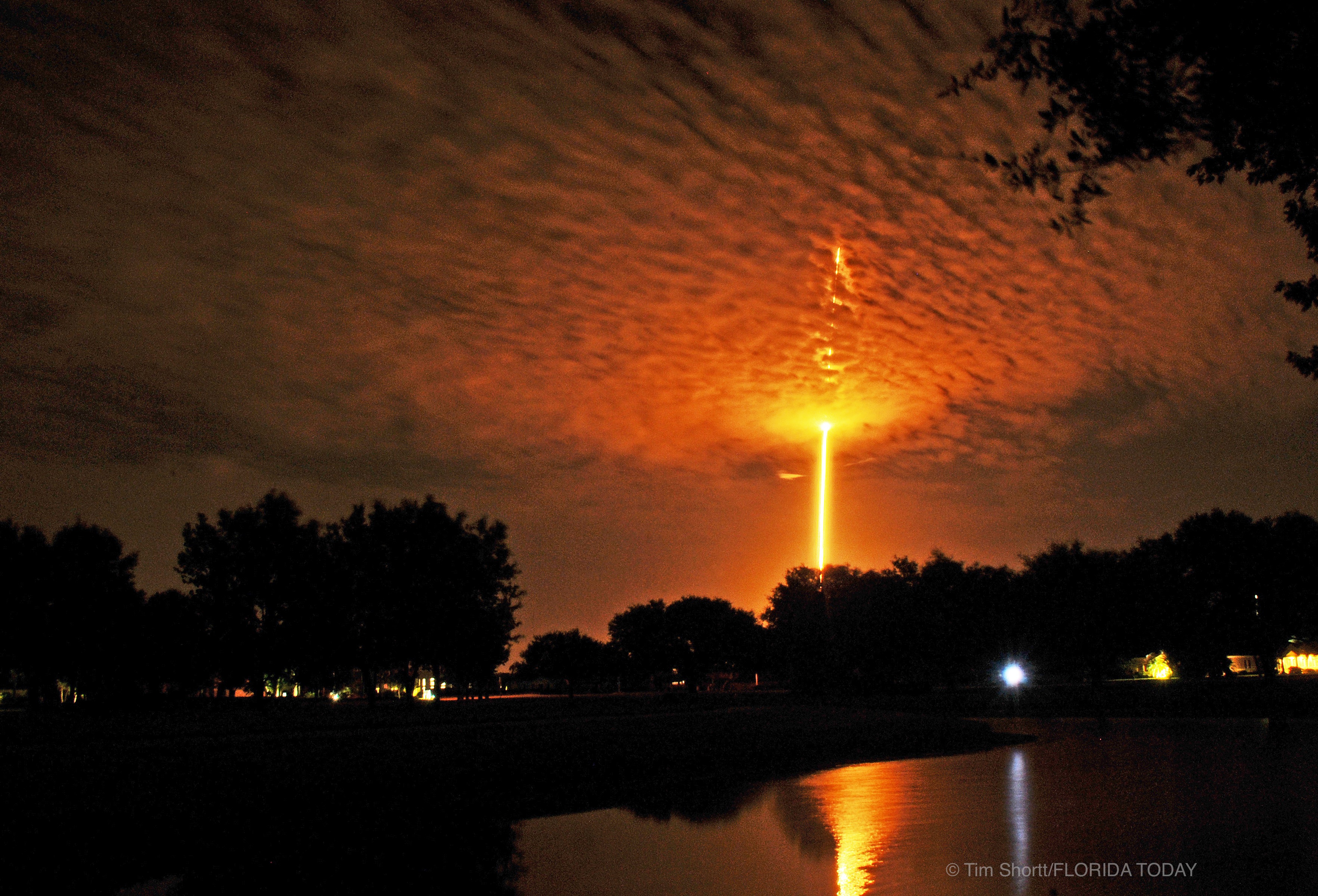
SpaceX Falcon 9 to Orbit
Image Credit & Copyright: Tim Shortt, Florida Today
Explanation: Birds don't fly this high. Airplanes don't go this fast. The Statue of Liberty weighs less. No species other than human can even comprehend what is going on, nor could any human just a millennium ago. The launch of a rocket bound for space is an event that inspires awe and challenges description. Pictured here, a SpaceX Falcon 9 V rocket lifted off through a cloud deck from Cape Canaveral, Florida last July to deliver cargo and supplies to the International Space Station. From a standing start, the 300,000+ kilogram rocket ship lifted its Dragon Capsule up to circle the Earth, where the outside air is too thin to breathe. Rockets bound for space are now launched from somewhere on Earth about once a week.

SpaceX Falcon 9 to Orbit
Image Credit & Copyright: Tim Shortt, Florida Today
Explanation: Birds don't fly this high. Airplanes don't go this fast. The Statue of Liberty weighs less. No species other than human can even comprehend what is going on, nor could any human just a millennium ago. The launch of a rocket bound for space is an event that inspires awe and challenges description. Pictured here, a SpaceX Falcon 9 V rocket lifted off through a cloud deck from Cape Canaveral, Florida last July to deliver cargo and supplies to the International Space Station. From a standing start, the 300,000+ kilogram rocket ship lifted its Dragon Capsule up to circle the Earth, where the outside air is too thin to breathe. Rockets bound for space are now launched from somewhere on Earth about once a week.

panosol- Αριθμός μηνυμάτων : 762
Points : 927
Reputation : 15
Ημερομηνία εγγραφής : 17/06/2012
Ηλικία : 56
 2017 January 23
2017 January 23
2017 January 23
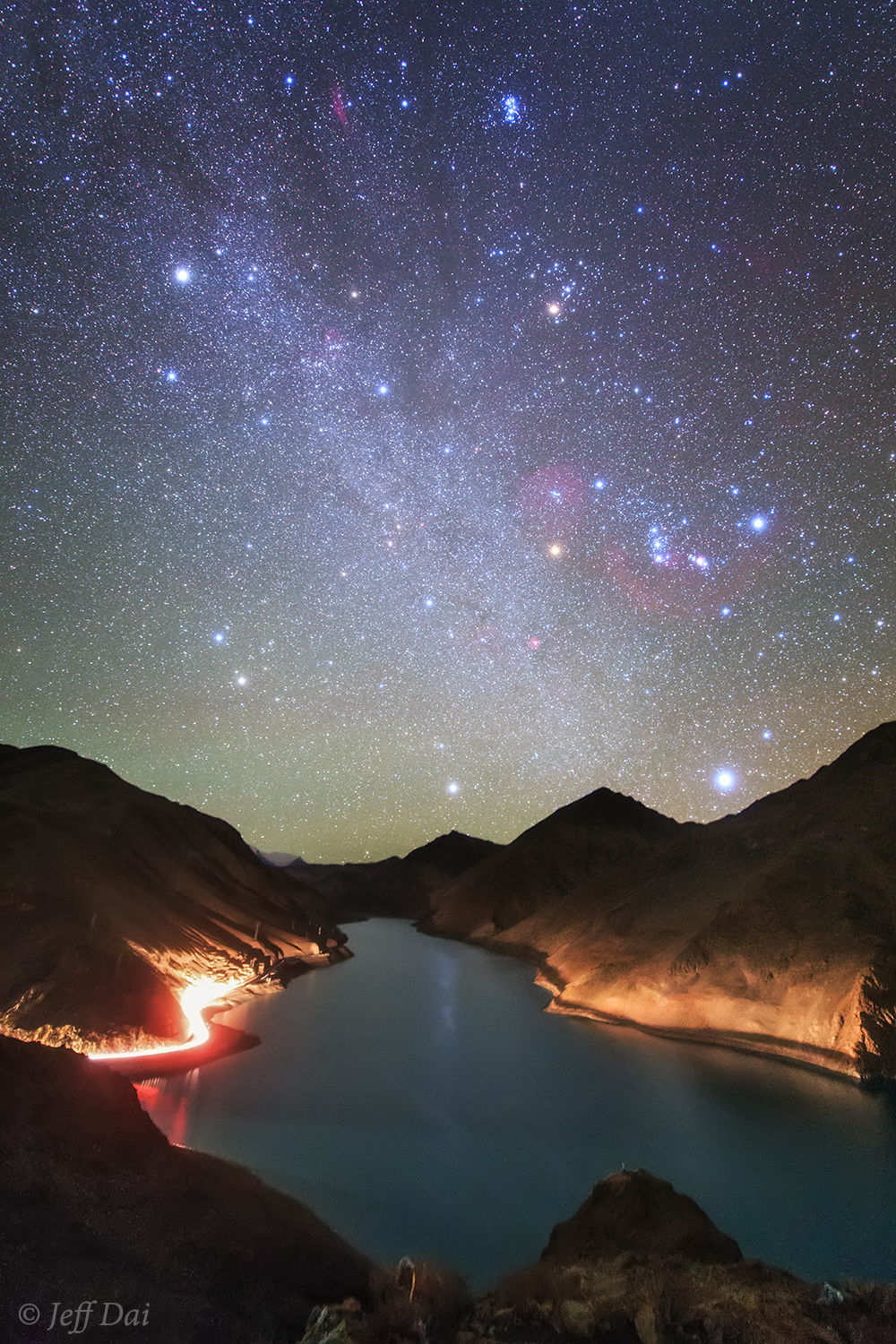
Winter Hexagon over Manla Reservoir
Image Credit & Copyright: Jeff Dai (TWAN)
Explanation: If you can find Orion, you might be able to find the Winter Hexagon. The Winter Hexagon involves some of the brightest stars visible, together forming a large and easily found pattern in the winter sky of Earth's northern hemisphere. The stars involved can usually be identified even in the bright night skies of a big city, although here they appeared recently in dark skies above the Manla Reservoir in Tibet, China. The six stars that compose the Winter Hexagon are Aldebaran, Capella, Castor (and Pollux), Procyon, Rigel, and Sirius. Here, the band of our Milky Way Galaxy runs through the center of the Winter Hexagon, while the Pleiades open star cluster is visible just above. The Winter Hexagon asterism engulfs several constellations including much of the iconic steppingstone Orion.

Winter Hexagon over Manla Reservoir
Image Credit & Copyright: Jeff Dai (TWAN)
Explanation: If you can find Orion, you might be able to find the Winter Hexagon. The Winter Hexagon involves some of the brightest stars visible, together forming a large and easily found pattern in the winter sky of Earth's northern hemisphere. The stars involved can usually be identified even in the bright night skies of a big city, although here they appeared recently in dark skies above the Manla Reservoir in Tibet, China. The six stars that compose the Winter Hexagon are Aldebaran, Capella, Castor (and Pollux), Procyon, Rigel, and Sirius. Here, the band of our Milky Way Galaxy runs through the center of the Winter Hexagon, while the Pleiades open star cluster is visible just above. The Winter Hexagon asterism engulfs several constellations including much of the iconic steppingstone Orion.

panosol- Αριθμός μηνυμάτων : 762
Points : 927
Reputation : 15
Ημερομηνία εγγραφής : 17/06/2012
Ηλικία : 56
 2017 January 24
2017 January 24
2017 January 24
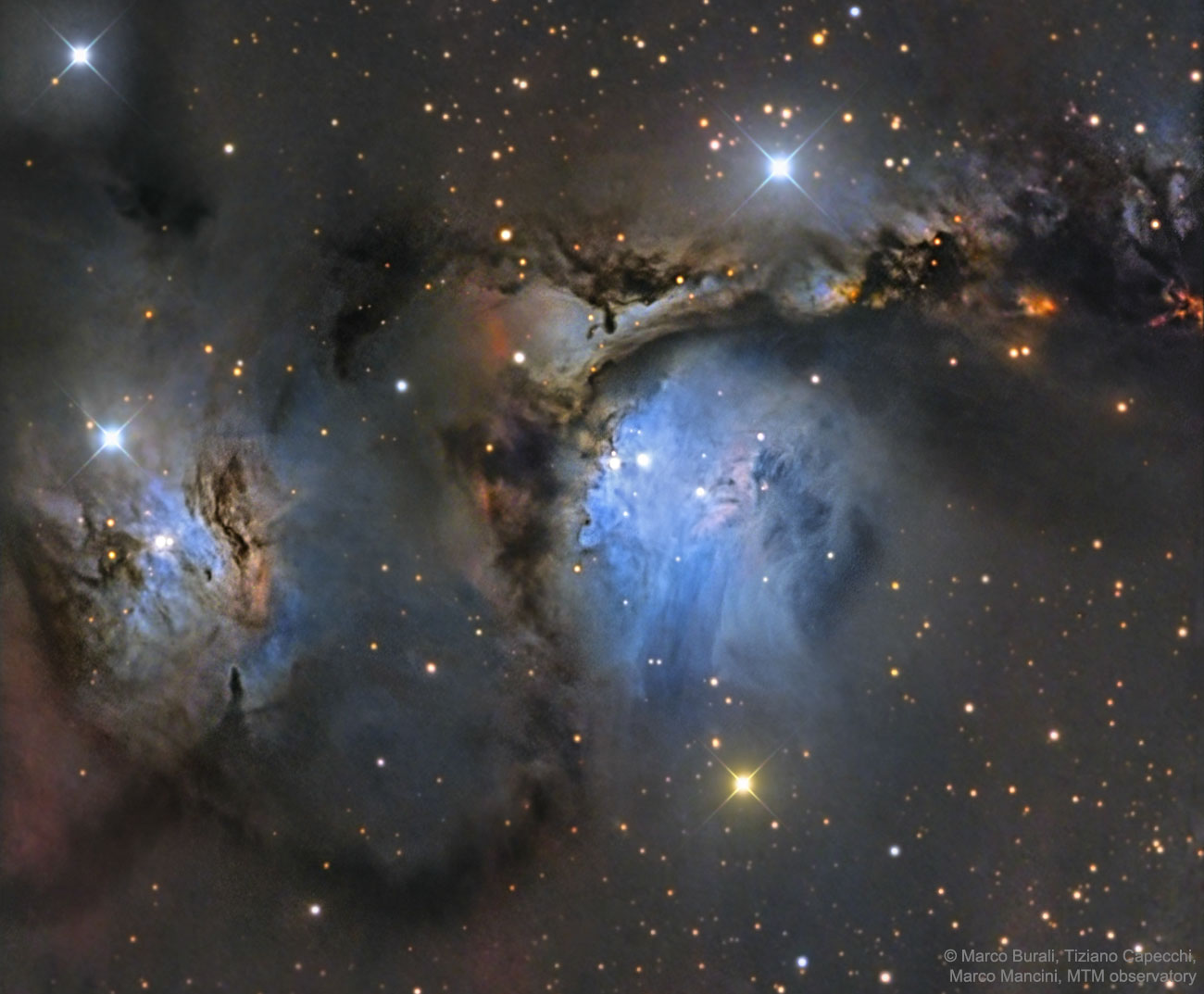
M78 and Orion Dust Reflections
Image Credit & Copyright: Marco Burali, Tiziano Capecchi, Marco Mancini (MTM observatory, Italy)
Explanation: In the vast Orion Molecular Cloud complex, several bright blue nebulas are particularly apparent. Pictured here are two of the most prominent reflection nebulas - dust clouds lit by the reflecting light of bright embedded stars. The more famous nebula is M78, in the image center, cataloged over 200 years ago. To its left is the lesser known NGC 2071. Astronomers continue to study these reflection nebulas to better understand how interior stars form. The Orion complex lies about 1500 light-years distant, contains the Orion and Horsehead nebulas, and covers much of the constellation of Orion.

M78 and Orion Dust Reflections
Image Credit & Copyright: Marco Burali, Tiziano Capecchi, Marco Mancini (MTM observatory, Italy)
Explanation: In the vast Orion Molecular Cloud complex, several bright blue nebulas are particularly apparent. Pictured here are two of the most prominent reflection nebulas - dust clouds lit by the reflecting light of bright embedded stars. The more famous nebula is M78, in the image center, cataloged over 200 years ago. To its left is the lesser known NGC 2071. Astronomers continue to study these reflection nebulas to better understand how interior stars form. The Orion complex lies about 1500 light-years distant, contains the Orion and Horsehead nebulas, and covers much of the constellation of Orion.

panosol- Αριθμός μηνυμάτων : 762
Points : 927
Reputation : 15
Ημερομηνία εγγραφής : 17/06/2012
Ηλικία : 56
 2017 January 25
2017 January 25
2017 January 25
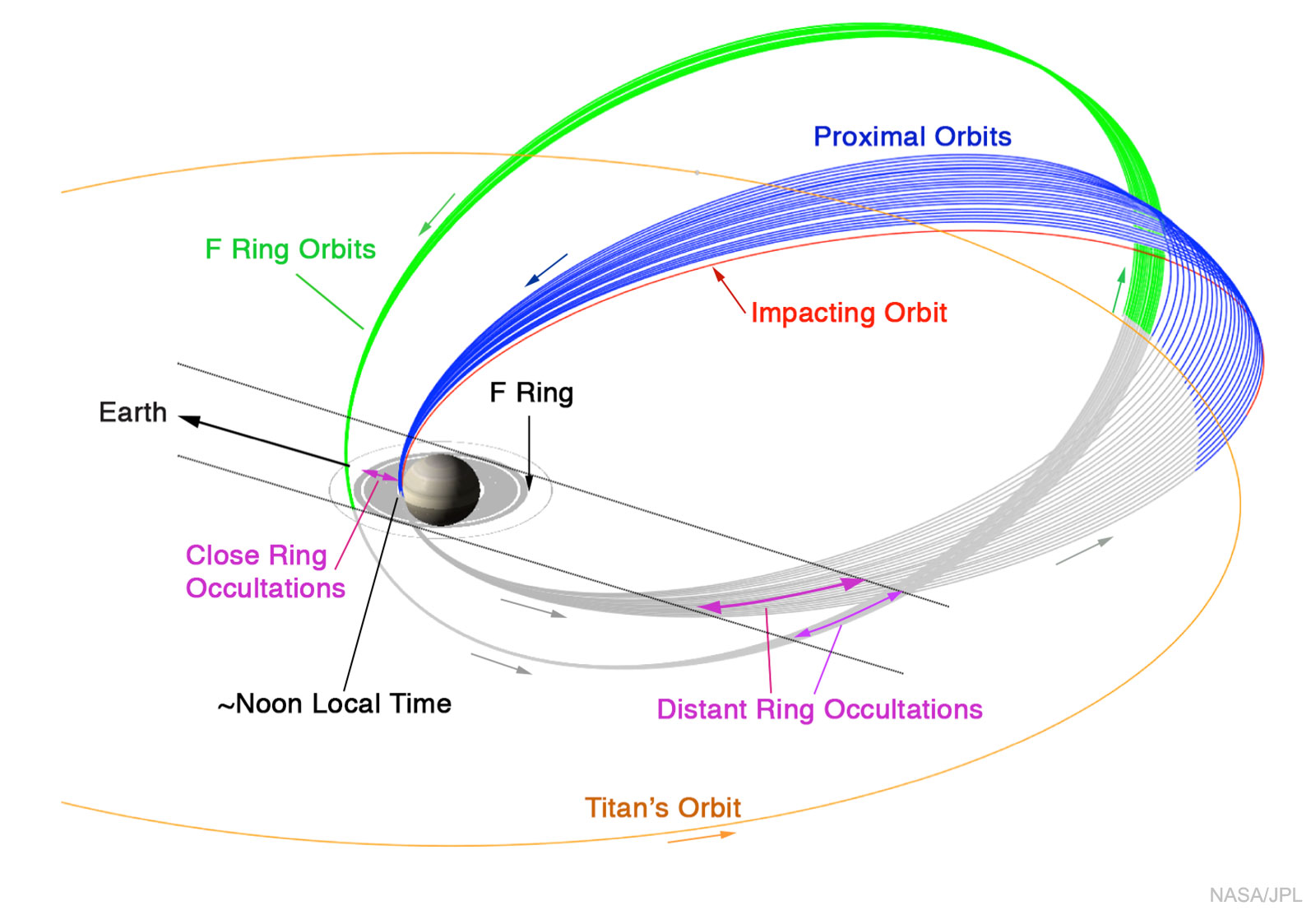
Cassini's Grand Finale Tour at Saturn
Image Credit: NASA, JPL-Caltech
Explanation: Cassini is being prepared to dive into Saturn. The robotic spacecraft that has been orbiting and exploring Saturn for over a decade will end its mission in September with a spectacular atmospheric plunge. Pictured here is a diagram of Cassini's remaining orbits, each taking about one week. Cassini is scheduled to complete a few months of orbits that will take it just outside Saturn's outermost ring F. Then, in April, Titan will give Cassini a gravitational pull into Proximal orbits, the last of which, on September 15, will impact Saturn and cause the spacecraft to implode and melt. Cassini's Grand Finale orbits are designed to record data and first-ever views from inside the rings -- between the rings and planet -- as well as some small moons interspersed in the rings. Cassini's demise is designed to protect any life that may occur around Saturn or its moons from contamination by Cassini itself.

Cassini's Grand Finale Tour at Saturn
Image Credit: NASA, JPL-Caltech
Explanation: Cassini is being prepared to dive into Saturn. The robotic spacecraft that has been orbiting and exploring Saturn for over a decade will end its mission in September with a spectacular atmospheric plunge. Pictured here is a diagram of Cassini's remaining orbits, each taking about one week. Cassini is scheduled to complete a few months of orbits that will take it just outside Saturn's outermost ring F. Then, in April, Titan will give Cassini a gravitational pull into Proximal orbits, the last of which, on September 15, will impact Saturn and cause the spacecraft to implode and melt. Cassini's Grand Finale orbits are designed to record data and first-ever views from inside the rings -- between the rings and planet -- as well as some small moons interspersed in the rings. Cassini's demise is designed to protect any life that may occur around Saturn or its moons from contamination by Cassini itself.

panosol- Αριθμός μηνυμάτων : 762
Points : 927
Reputation : 15
Ημερομηνία εγγραφής : 17/06/2012
Ηλικία : 56
 2017 January 26
2017 January 26
2017 January 26

GOES-16: Moon over Planet Earth
Image Credit: NOAA, NASA
Explanation: Launched last November 19 from Cape Canaveral Air Force Station, the satellite now known as GOES-16 can now observe planet Earth from a geostationary orbit 22,300 miles above the equator. Its Advanced Baseline Imager captured this contrasting view of Earth and a gibbous Moon on January 15. The stark and airless Moon is not really the focus of GOES-16, though. Capable of providing a high resolution full disk image of Earth every 15 minutes in 16 spectral channels, the new generation satellite's instrumentation is geared to provide sharper, more detailed views of Earth's dynamic weather systems and enable more accurate weather forecasting. Like previous GOES weather satellites, GOES-16 will use the moon over our fair planet as a calibration target.

GOES-16: Moon over Planet Earth
Image Credit: NOAA, NASA
Explanation: Launched last November 19 from Cape Canaveral Air Force Station, the satellite now known as GOES-16 can now observe planet Earth from a geostationary orbit 22,300 miles above the equator. Its Advanced Baseline Imager captured this contrasting view of Earth and a gibbous Moon on January 15. The stark and airless Moon is not really the focus of GOES-16, though. Capable of providing a high resolution full disk image of Earth every 15 minutes in 16 spectral channels, the new generation satellite's instrumentation is geared to provide sharper, more detailed views of Earth's dynamic weather systems and enable more accurate weather forecasting. Like previous GOES weather satellites, GOES-16 will use the moon over our fair planet as a calibration target.

panosol- Αριθμός μηνυμάτων : 762
Points : 927
Reputation : 15
Ημερομηνία εγγραφής : 17/06/2012
Ηλικία : 56
 2017 January 27
2017 January 27
2017 January 27
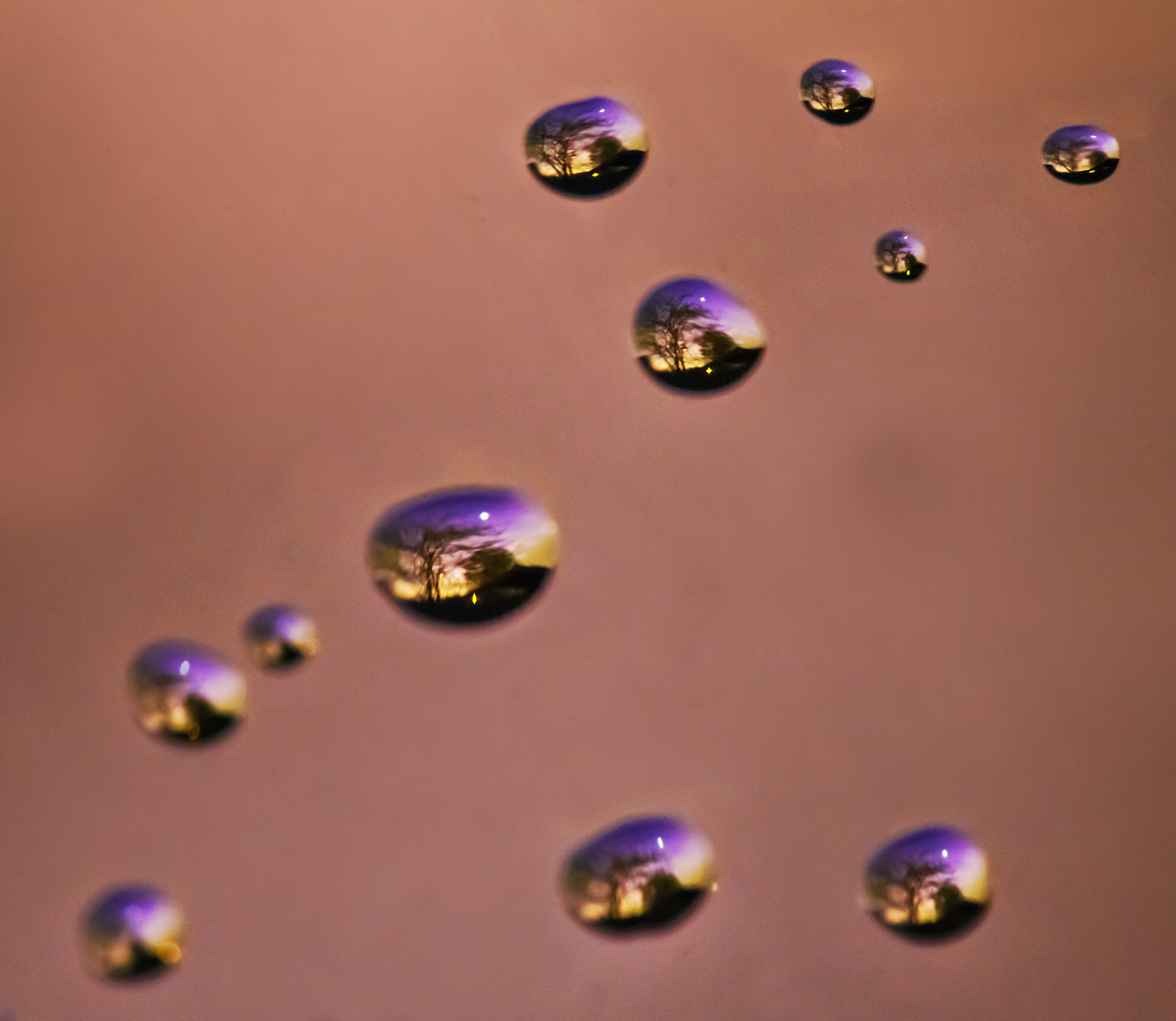
Venus Through Water Drops
Image Credit & Copyright: John Bell
Explanation: Now the brilliant "star" in planet Earth's evening skies, Venus is captured in this creative astrophotograph. Taken with a close-focusing lens on January 18 from Milton Keynes, UK, it shows multiple images of the sky above the western horizon shortly after sunset. The images were created by water drops on a glass pane fixed to a tree. Surface tension has drawn the water drops into simple lens-like shapes. Refracting light, the drops create images that are upside-down, so the scene has been rotated to allow comfortable right-side up viewing of a macro-multiple-skyscape.

Venus Through Water Drops
Image Credit & Copyright: John Bell
Explanation: Now the brilliant "star" in planet Earth's evening skies, Venus is captured in this creative astrophotograph. Taken with a close-focusing lens on January 18 from Milton Keynes, UK, it shows multiple images of the sky above the western horizon shortly after sunset. The images were created by water drops on a glass pane fixed to a tree. Surface tension has drawn the water drops into simple lens-like shapes. Refracting light, the drops create images that are upside-down, so the scene has been rotated to allow comfortable right-side up viewing of a macro-multiple-skyscape.

panosol- Αριθμός μηνυμάτων : 762
Points : 927
Reputation : 15
Ημερομηνία εγγραφής : 17/06/2012
Ηλικία : 56
 2017 January 28
2017 January 28
2017 January 28
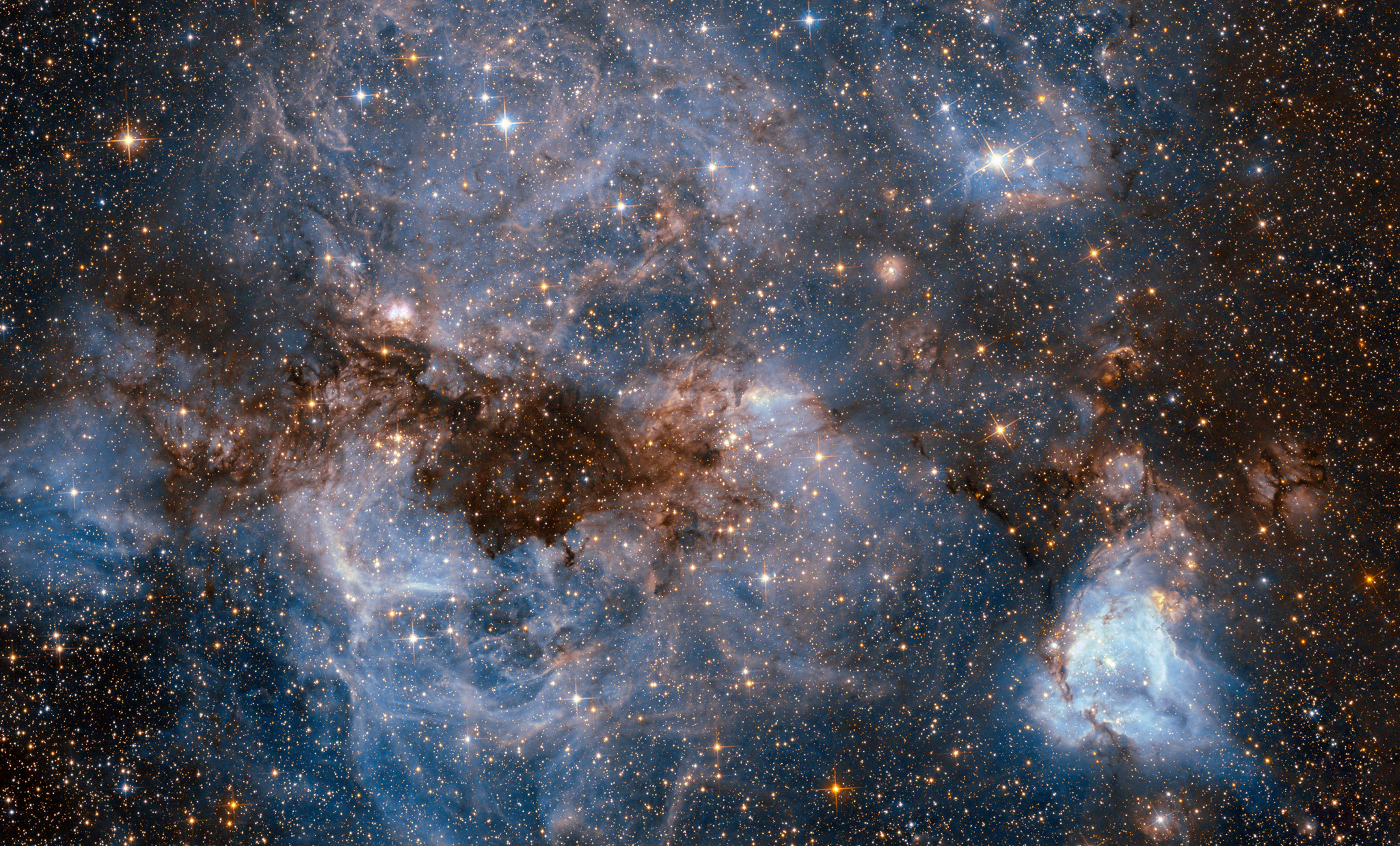
N159 in the Large Magellanic Cloud
Image Credit: NASA, ESA, Hubble Space Telescope
Explanation: Over 150 light-years across, this cosmic maelstrom of gas and dust is not too far away. It lies south of the Tarantula Nebula in our satellite galaxy the Large Magellanic Cloud a mere 180,000 light-years distant. Massive stars have formed within. Their energetic radiation and powerful stellar winds sculpt the gas and dust and power the glow of this HII region, entered into the Henize catalog of emission stars and nebulae in the Magellanic Clouds as N159. The bright, compact, butterfly-shaped nebula above and left of center likely contains massive stars in a very early stage of formation. Resolved for the first time in Hubble images, the compact blob of ionized gas has come to be known as the Papillon Nebula.

N159 in the Large Magellanic Cloud
Image Credit: NASA, ESA, Hubble Space Telescope
Explanation: Over 150 light-years across, this cosmic maelstrom of gas and dust is not too far away. It lies south of the Tarantula Nebula in our satellite galaxy the Large Magellanic Cloud a mere 180,000 light-years distant. Massive stars have formed within. Their energetic radiation and powerful stellar winds sculpt the gas and dust and power the glow of this HII region, entered into the Henize catalog of emission stars and nebulae in the Magellanic Clouds as N159. The bright, compact, butterfly-shaped nebula above and left of center likely contains massive stars in a very early stage of formation. Resolved for the first time in Hubble images, the compact blob of ionized gas has come to be known as the Papillon Nebula.

panosol- Αριθμός μηνυμάτων : 762
Points : 927
Reputation : 15
Ημερομηνία εγγραφής : 17/06/2012
Ηλικία : 56
 2017 January 29
2017 January 29
2017 January 29

Red Aurora Over Australia
Image Credit & Copyright: Alex Cherney (Terrastro, TWAN)
Explanation: Why would the sky glow red? Aurora. A solar storm in 2012, emanating mostly from active sunspot region 1402, showered particles on the Earth that excited oxygen atoms high in the Earth's atmosphere. As the excited element's electrons fell back to their ground state, they emitted a red glow. Were oxygen atoms lower in Earth's atmosphere excited, the glow would be predominantly green. Pictured here, this high red aurora is visible just above the horizon last week near Flinders, Victoria, Australia. The sky that night, however, also glowed with more familiar but more distant objects, including the central disk of our Milky Way Galaxy on the left, and the neighboring Large and Small Magellanic Cloud galaxies on the right. A time-lapse video highlighting auroras visible that night puts the picturesque scene in context. Why the sky did not also glow green remains unknown.

Red Aurora Over Australia
Image Credit & Copyright: Alex Cherney (Terrastro, TWAN)
Explanation: Why would the sky glow red? Aurora. A solar storm in 2012, emanating mostly from active sunspot region 1402, showered particles on the Earth that excited oxygen atoms high in the Earth's atmosphere. As the excited element's electrons fell back to their ground state, they emitted a red glow. Were oxygen atoms lower in Earth's atmosphere excited, the glow would be predominantly green. Pictured here, this high red aurora is visible just above the horizon last week near Flinders, Victoria, Australia. The sky that night, however, also glowed with more familiar but more distant objects, including the central disk of our Milky Way Galaxy on the left, and the neighboring Large and Small Magellanic Cloud galaxies on the right. A time-lapse video highlighting auroras visible that night puts the picturesque scene in context. Why the sky did not also glow green remains unknown.

panosol- Αριθμός μηνυμάτων : 762
Points : 927
Reputation : 15
Ημερομηνία εγγραφής : 17/06/2012
Ηλικία : 56
 2017 January 30
2017 January 30
2017 January 30

The Cat's Eye Nebula from Hubble
Image Credit: NASA, ESA, Hubble, HLA; Reprocessing & Copyright: Raul Villaverde
Explanation: To some, it may look like a cat's eye. The alluring Cat's Eye nebula, however, lies three thousand light-years from Earth across interstellar space. A classic planetary nebula, the Cat's Eye (NGC 6543) represents a final, brief yet glorious phase in the life of a sun-like star. This nebula's dying central star may have produced the simple, outer pattern of dusty concentric shells by shrugging off outer layers in a series of regular convulsions. But the formation of the beautiful, more complex inner structures is not well understood. Seen so clearly in this digitally reprocessed Hubble Space Telescope image, the truly cosmic eye is over half a light-year across. Of course, gazing into this Cat's Eye, astronomers may well be seeing the fate of our sun, destined to enter its own planetary nebula phase of evolution ... in about 5 billion years.

The Cat's Eye Nebula from Hubble
Image Credit: NASA, ESA, Hubble, HLA; Reprocessing & Copyright: Raul Villaverde
Explanation: To some, it may look like a cat's eye. The alluring Cat's Eye nebula, however, lies three thousand light-years from Earth across interstellar space. A classic planetary nebula, the Cat's Eye (NGC 6543) represents a final, brief yet glorious phase in the life of a sun-like star. This nebula's dying central star may have produced the simple, outer pattern of dusty concentric shells by shrugging off outer layers in a series of regular convulsions. But the formation of the beautiful, more complex inner structures is not well understood. Seen so clearly in this digitally reprocessed Hubble Space Telescope image, the truly cosmic eye is over half a light-year across. Of course, gazing into this Cat's Eye, astronomers may well be seeing the fate of our sun, destined to enter its own planetary nebula phase of evolution ... in about 5 billion years.

panosol- Αριθμός μηνυμάτων : 762
Points : 927
Reputation : 15
Ημερομηνία εγγραφής : 17/06/2012
Ηλικία : 56
 2017 January 31
2017 January 31
2017 January 31
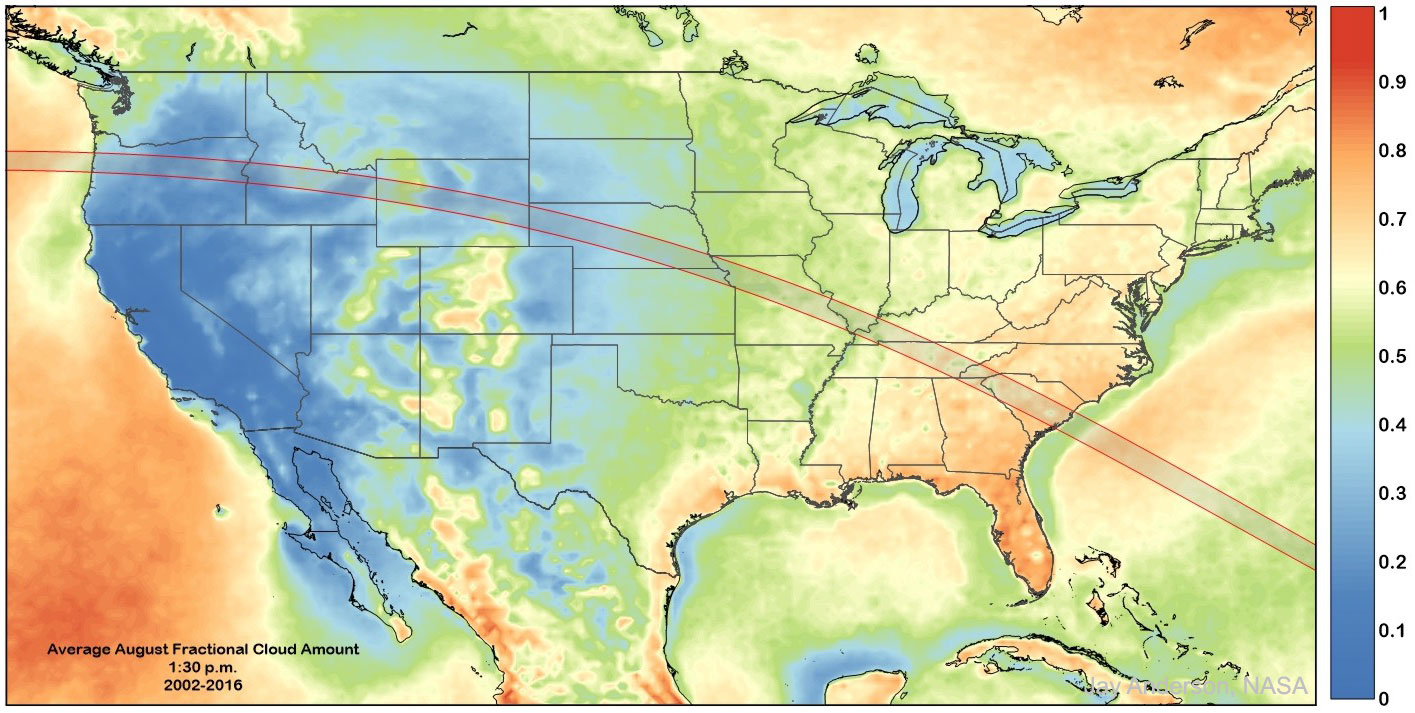
Where to See the American Eclipse
Image Credit: Jay Anderson; Data: MODIS Satellite, NASA's GSFC
Explanation: Are you planning to see the American Eclipse on August 21? A few hours after sunrise, a rare total eclipse of the Sun will be visible along a narrow path across the USA. Those only near the path will see a partial eclipse. Although some Americans live right in path of totality, surely many more will be able to get there after a well-planned drive. One problem with eclipses, though, is that clouds sometimes get in the way. To increase your clear-viewing odds, you might consult the featured map and find a convenient destination with a historically low chance (more blue) of thick clouds overhead during totality. Given the large fraction of Americans carrying camera-equipped smartphones, this American Eclipse may turn out to be the most photographed event in the history of the world.

Where to See the American Eclipse
Image Credit: Jay Anderson; Data: MODIS Satellite, NASA's GSFC
Explanation: Are you planning to see the American Eclipse on August 21? A few hours after sunrise, a rare total eclipse of the Sun will be visible along a narrow path across the USA. Those only near the path will see a partial eclipse. Although some Americans live right in path of totality, surely many more will be able to get there after a well-planned drive. One problem with eclipses, though, is that clouds sometimes get in the way. To increase your clear-viewing odds, you might consult the featured map and find a convenient destination with a historically low chance (more blue) of thick clouds overhead during totality. Given the large fraction of Americans carrying camera-equipped smartphones, this American Eclipse may turn out to be the most photographed event in the history of the world.

panosol- Αριθμός μηνυμάτων : 762
Points : 927
Reputation : 15
Ημερομηνία εγγραφής : 17/06/2012
Ηλικία : 56
 2017 February 1
2017 February 1
2017 February 1
Four Planets Orbiting Star HR 8799
Video Credit & CC BY License: J. Wang (UC Berkeley) & C. Marois (Herzberg Astrophysics), NExSS (NASA), Keck Obs.
Explanation: Does life exist outside our Solar System? To help find out, NASA has created the Nexus for Exoplanet System Science (NExSS) to better locate and study distant star systems that hold hope of harboring living inhabitants. A new observational result from a NExSS collaboration is the featured time-lapse video of recently discovered planets orbiting the star HR 8799. The images for the video were taken over seven years from the Keck Observatory in Hawaii. Four exoplanets appear as white dots partially circling their parent star, purposefully occluded in the center. The central star HR 8799 is slightly larger and more massive than our Sun, while each of the planets is thought to be a few times the mass of Jupiter. The HR 8799 system lies about 130 light years away toward the constellation of the Flying Horse (Pegasus). Research will now continue on whether any known or potential planets -- or even moons of these planets -- in the HR 8799 star system could harbor life.
Four Planets Orbiting Star HR 8799
Video Credit & CC BY License: J. Wang (UC Berkeley) & C. Marois (Herzberg Astrophysics), NExSS (NASA), Keck Obs.
Explanation: Does life exist outside our Solar System? To help find out, NASA has created the Nexus for Exoplanet System Science (NExSS) to better locate and study distant star systems that hold hope of harboring living inhabitants. A new observational result from a NExSS collaboration is the featured time-lapse video of recently discovered planets orbiting the star HR 8799. The images for the video were taken over seven years from the Keck Observatory in Hawaii. Four exoplanets appear as white dots partially circling their parent star, purposefully occluded in the center. The central star HR 8799 is slightly larger and more massive than our Sun, while each of the planets is thought to be a few times the mass of Jupiter. The HR 8799 system lies about 130 light years away toward the constellation of the Flying Horse (Pegasus). Research will now continue on whether any known or potential planets -- or even moons of these planets -- in the HR 8799 star system could harbor life.

panosol- Αριθμός μηνυμάτων : 762
Points : 927
Reputation : 15
Ημερομηνία εγγραφής : 17/06/2012
Ηλικία : 56
 2017 February 2
2017 February 2
2017 February 2
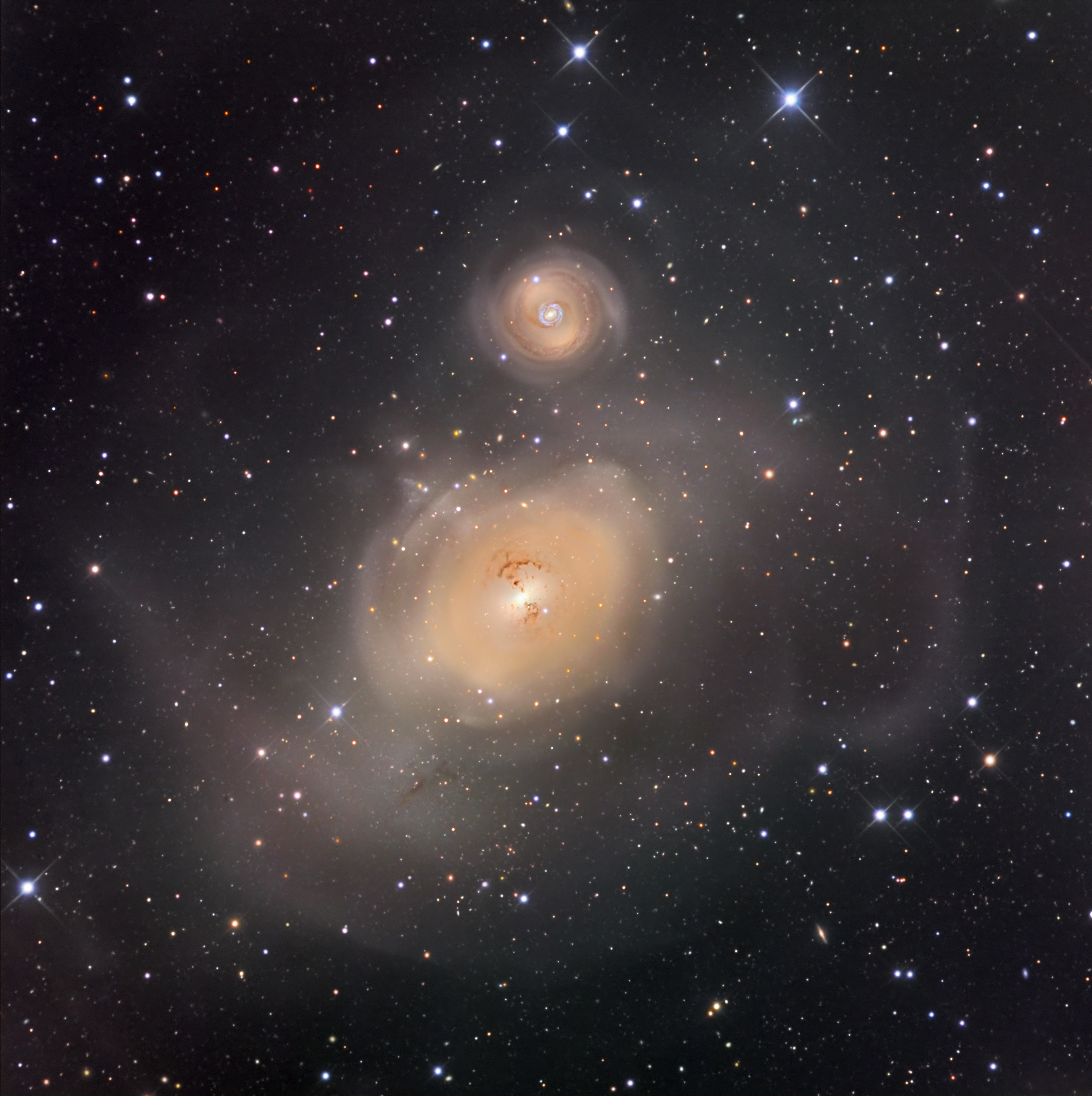
NGC 1316: After Galaxies Collide
Image Credit & Copyright: Steve Mazlin, Warren Keller, and Steve Menaker (SSRO / UNC / PROMPT / CTIO)
Explanation: An example of violence on a cosmic scale, enormous elliptical galaxy NGC 1316 lies about 75 million light-years away toward Fornax, the southern constellation of the Furnace. Investigating the startling sight, astronomers suspect the giant galaxy of colliding with smaller neighbor NGC 1317 seen just above, causing far flung loops and shells of stars. Light from their close encounter would have reached Earth some 100 million years ago. In the deep, sharp image, the central regions of NGC 1316 and NGC 1317 appear separated by over 100,000 light-years. Complex dust lanes visible within also indicate that NGC 1316 is itself the result of a merger of galaxies in the distant past. Found on the outskirts of the Fornax galaxy cluster, NGC 1316 is known as Fornax A. One of the visually brightest of the Fornax cluster galaxies it is one of the strongest and largest radio sources with radio emission extending well beyond this telescopic field-of-view, over several degrees on the sky.

NGC 1316: After Galaxies Collide
Image Credit & Copyright: Steve Mazlin, Warren Keller, and Steve Menaker (SSRO / UNC / PROMPT / CTIO)
Explanation: An example of violence on a cosmic scale, enormous elliptical galaxy NGC 1316 lies about 75 million light-years away toward Fornax, the southern constellation of the Furnace. Investigating the startling sight, astronomers suspect the giant galaxy of colliding with smaller neighbor NGC 1317 seen just above, causing far flung loops and shells of stars. Light from their close encounter would have reached Earth some 100 million years ago. In the deep, sharp image, the central regions of NGC 1316 and NGC 1317 appear separated by over 100,000 light-years. Complex dust lanes visible within also indicate that NGC 1316 is itself the result of a merger of galaxies in the distant past. Found on the outskirts of the Fornax galaxy cluster, NGC 1316 is known as Fornax A. One of the visually brightest of the Fornax cluster galaxies it is one of the strongest and largest radio sources with radio emission extending well beyond this telescopic field-of-view, over several degrees on the sky.

panosol- Αριθμός μηνυμάτων : 762
Points : 927
Reputation : 15
Ημερομηνία εγγραφής : 17/06/2012
Ηλικία : 56
 2017 February 3
2017 February 3
2017 February 3
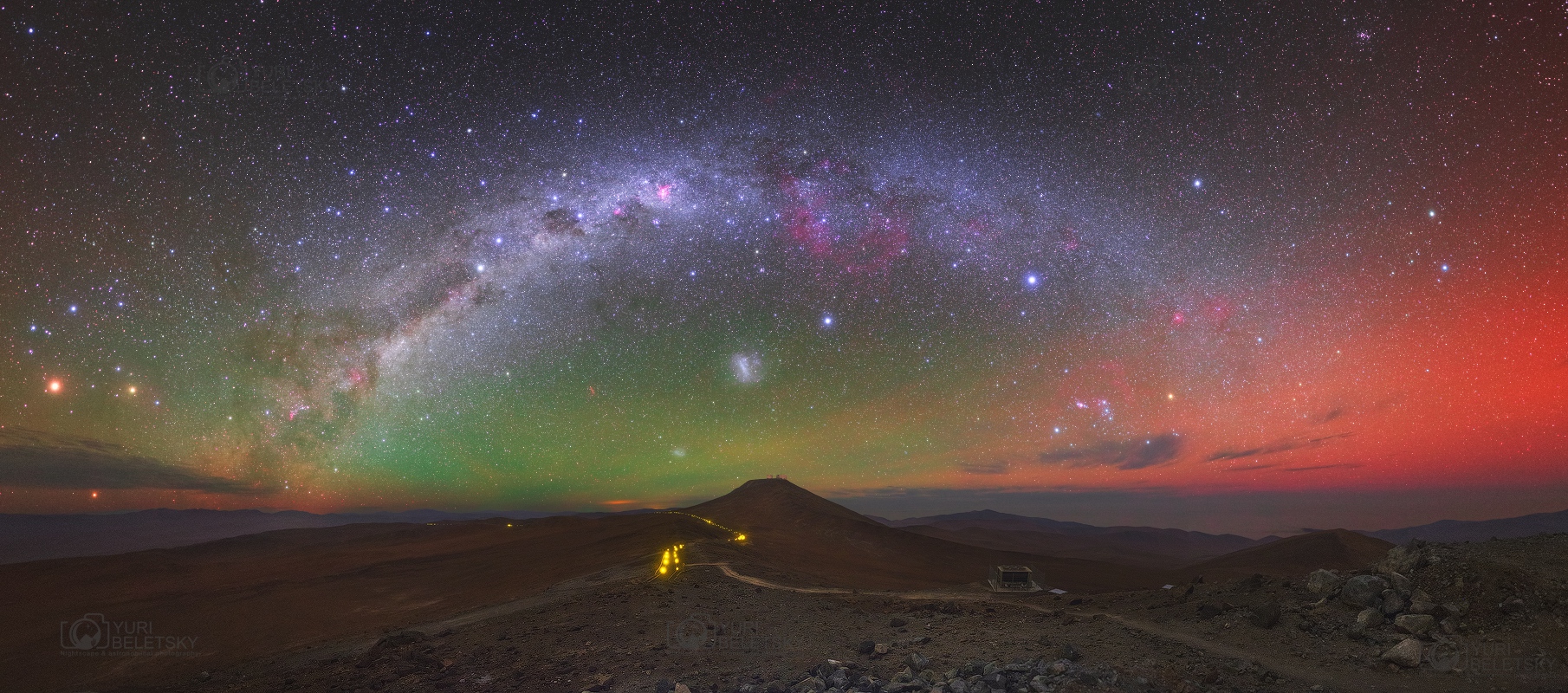
Milky Way with Airglow Australis
Image Credit & Copyright: Yuri Beletsky (Carnegie Las Campanas Observatory, TWAN)
Explanation: Captured last April after sunset on a Chilean winter's night an exceptionally intense airglow flooded this scene. The panoramic skyscape is also filled with stars, clusters, and nebulae along the southern Milky Way including the Large and Small Magellanic clouds. Originating at an altitude similar to aurorae, the luminous airglow is due to chemiluminescence, the production of light through chemical excitation. Commonly recorded with a greenish tinge by sensitive digital cameras, both red and green airglow emission here is predominately from atmospheric oxygen atoms at extremely low densities and has often been present in southern hemisphere nights during the last few years. Like the Milky Way on that dark night the strong airglow was visible to the eye, but seen without color. Mars, Saturn, and bright star Antares in Scorpius form the celestial triangle anchoring the scene on the left. The road leads toward the 2,600 meter high mountain Cerro Paranal and the European Southern Observatory's Very Large Telescopes.

Milky Way with Airglow Australis
Image Credit & Copyright: Yuri Beletsky (Carnegie Las Campanas Observatory, TWAN)
Explanation: Captured last April after sunset on a Chilean winter's night an exceptionally intense airglow flooded this scene. The panoramic skyscape is also filled with stars, clusters, and nebulae along the southern Milky Way including the Large and Small Magellanic clouds. Originating at an altitude similar to aurorae, the luminous airglow is due to chemiluminescence, the production of light through chemical excitation. Commonly recorded with a greenish tinge by sensitive digital cameras, both red and green airglow emission here is predominately from atmospheric oxygen atoms at extremely low densities and has often been present in southern hemisphere nights during the last few years. Like the Milky Way on that dark night the strong airglow was visible to the eye, but seen without color. Mars, Saturn, and bright star Antares in Scorpius form the celestial triangle anchoring the scene on the left. The road leads toward the 2,600 meter high mountain Cerro Paranal and the European Southern Observatory's Very Large Telescopes.

panosol- Αριθμός μηνυμάτων : 762
Points : 927
Reputation : 15
Ημερομηνία εγγραφής : 17/06/2012
Ηλικία : 56
 2017 February 4
2017 February 4
2017 February 4
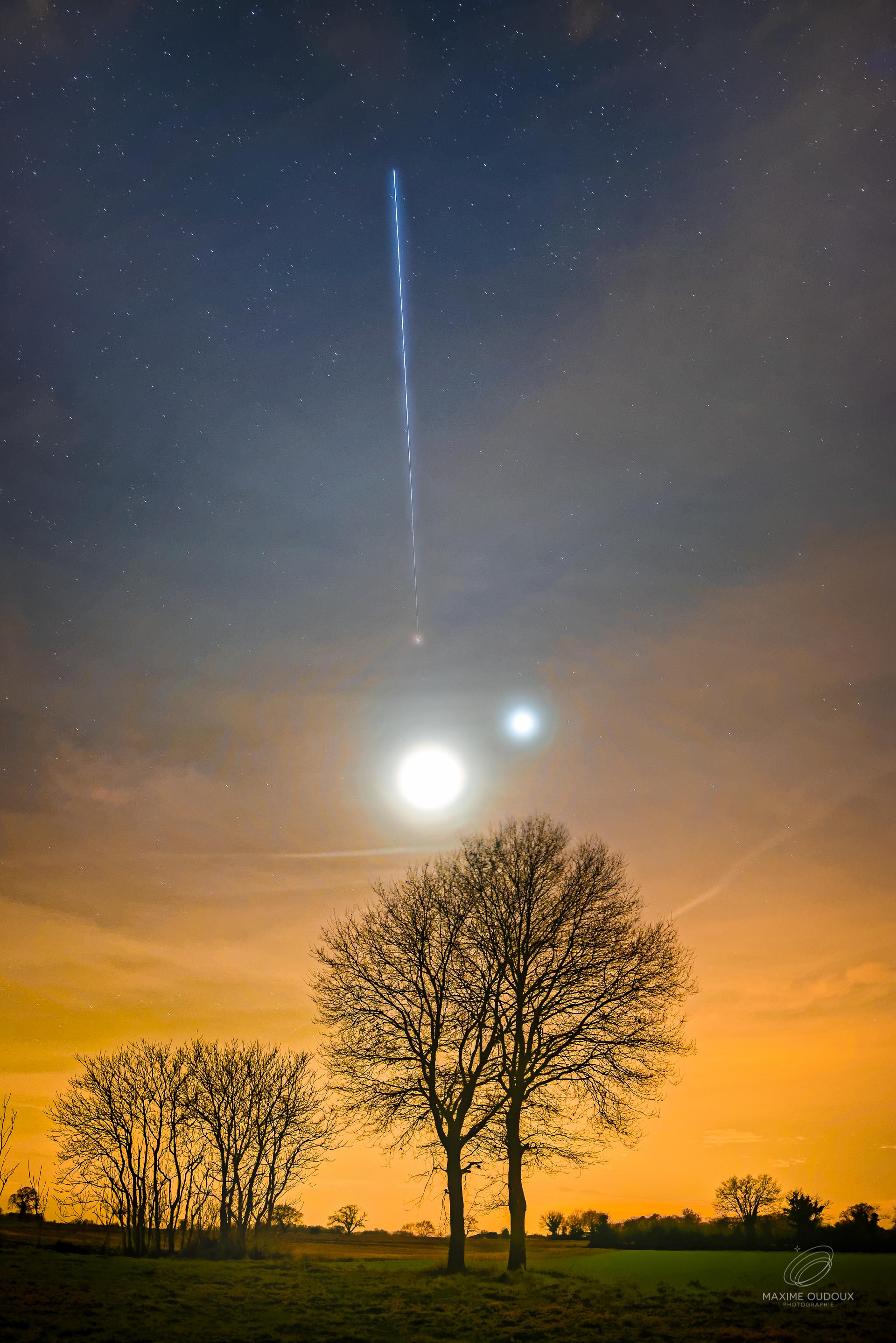
Conjunction of Four
Image Credit & Copyright: Maxime Oudoux
Explanation: On January 31, a waxing crescent Moon, brilliant Venus, and fainter Mars gathered in the fading twilight, hanging above the western horizon just after sunset on planet Earth. In this combined evening skyscape, the lovely celestial triangle is seen through clouds and haze. Still glinting in sunlight, from low Earth orbit the International Space Station briefly joined the trio that evening in skies near Le Lude, France. The photographer's line-of-sight to the space station was remarkably close to Mars as the initial exposure began. As a result, the station's bright streak seems to leap from the Red Planet, moving toward darker skies at the top of the frame.

Conjunction of Four
Image Credit & Copyright: Maxime Oudoux
Explanation: On January 31, a waxing crescent Moon, brilliant Venus, and fainter Mars gathered in the fading twilight, hanging above the western horizon just after sunset on planet Earth. In this combined evening skyscape, the lovely celestial triangle is seen through clouds and haze. Still glinting in sunlight, from low Earth orbit the International Space Station briefly joined the trio that evening in skies near Le Lude, France. The photographer's line-of-sight to the space station was remarkably close to Mars as the initial exposure began. As a result, the station's bright streak seems to leap from the Red Planet, moving toward darker skies at the top of the frame.

panosol- Αριθμός μηνυμάτων : 762
Points : 927
Reputation : 15
Ημερομηνία εγγραφής : 17/06/2012
Ηλικία : 56
 2017 February 5
2017 February 5
2017 February 5

Odysseus Crater on Tethys
Image Credit: Cassini Imaging Team, SSI, JPL, ESA, NASA
Explanation: Some moons wouldn't survive the collision. Tethys, one of Saturn's larger moons at about 1000 kilometers in diameter, survived the collision, but today exhibits the resulting expansive impact crater Odysseus. Sometimes called the Great Basin, Odysseus occurs on the leading hemisphere of Tethys and shows its great age by the relative amount of smaller craters that occur inside its towering walls. The density of Tethys is similar to water-ice. The featured image was captured in November by the robotic Cassini spacecraft in orbit around Saturn as it swooped past the giant ice ball. Cassini has now started on its Grand Finale Tour which will take it inside Saturn's rings and culminate in September with a dive into Saturn's thick atmosphere.

Odysseus Crater on Tethys
Image Credit: Cassini Imaging Team, SSI, JPL, ESA, NASA
Explanation: Some moons wouldn't survive the collision. Tethys, one of Saturn's larger moons at about 1000 kilometers in diameter, survived the collision, but today exhibits the resulting expansive impact crater Odysseus. Sometimes called the Great Basin, Odysseus occurs on the leading hemisphere of Tethys and shows its great age by the relative amount of smaller craters that occur inside its towering walls. The density of Tethys is similar to water-ice. The featured image was captured in November by the robotic Cassini spacecraft in orbit around Saturn as it swooped past the giant ice ball. Cassini has now started on its Grand Finale Tour which will take it inside Saturn's rings and culminate in September with a dive into Saturn's thick atmosphere.

panosol- Αριθμός μηνυμάτων : 762
Points : 927
Reputation : 15
Ημερομηνία εγγραφής : 17/06/2012
Ηλικία : 56
Σελίδα 2 από 15 •  1, 2, 3 ... 8 ... 15
1, 2, 3 ... 8 ... 15 
Σελίδα 2 από 15
Δικαιώματα σας στην κατηγορία αυτή
Δεν μπορείτε να απαντήσετε στα Θέματα αυτής της Δ.Συζήτησης|
|
|

 Αρχική
Αρχική Φόρουμ
Φόρουμ RADIO
RADIO ΠΑΙΓΝΙΔΙΑ
ΠΑΙΓΝΙΔΙΑ Latest images
Latest images Εγγραφή
Εγγραφή Σύνδεση
Σύνδεση




» ΚΑΛΗ ΑΝΑΣΤΑΣΗ ΚΑΙ ΚΑΛΟ ΠΑΣΧΑ!!
» Εφυγε από τη ζωή ο Τζίμης Πανούσης
» ΧΡΟΝΙΑ ΠΟΛΛΑ ΚΑΙ ΚΑΛΗ ΧΡΟΝΙΑ ΜΕ ΥΓΕΙΑ ΚΑΙ ΕΥΤΥΧΙΑ!!!
» This day in music
» Astronomy Picture of the Day
» Τις καλύτερες ευχές μου για Ευτυχισμένα Χριστούγεννα σε όλους!!
» ΖΗΤΩ Η 28η ΟΚΤΩΒΡΙΟΥ 1940
» ΖΗΤΩ Η 28η ΟΚΤΩΒΡΙΟΥ 1940
» Το τελευταίο αντίο στη Ζωή Λάσκαρη
» 19 Μαΐου: Ημέρα Μνήμης της Γενοκτονίας των Ποντίων
» Kαλό σου ταξίδι!!
» ΧΡΙΣΤΟΣ ΑΝΕΣΤΗ!!
» ΚΑΛΗ ΜΕΓΑΛΗ ΕΒΔΟΜΑΔΑ!!
» ΚΑΛΟ ΜΗΝΑ!!!
» ΧΡΟΝΙΑ ΠΟΛΛΑ!!
» ΧΡΟΝΙΑ ΠΟΛΛΑ!!
» R.I.P. Chuck Berry
» 8 Μαρτίου - Παγκόσμια Ημέρα της Γυναίκας
» ΧΡΟΝΙΑ ΠΟΛΛΑ ΚΑΙ ΚΑΛΗ ΣΑΡΑΚΟΣΤΗ!!